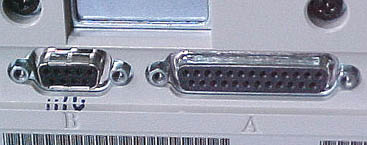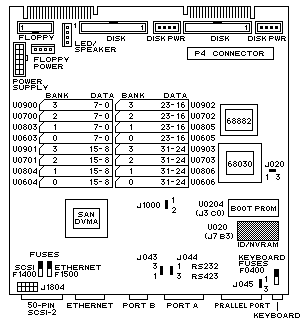SUN 3/80


This Page is IN PROGRESS, so bear with me while I sort it all out.
Hardware FAQ Info
3/80 Processor(s): 68030 @ 20MHz, 68882 @ 20 or 40MHz, 68030 on-chip MMU, 3 MIPS, 0.16 MFLOPS CPU: 501-1401/1650 Chassis type: square pizza box Bus: P4 connector (not same as P4 on 3/60) Memory: 16M or 40M physical, 4G virtual, 100ns cycle Notes: Similar packaging to SparcStation 1. Parallel port, SCSI port, AUI Ethernet, 1.44M 3.5" floppy (720K on early units?). No onboard framebuffer. Code-named "Hydra". Type-4 keyboard and Sun-4 mouse, plugged together and into the machine with a small DIN plug. Boot ROM versions 3.0.2 and later allow using 4M SIMMs in some slots for up to 40M.The 3/80 breaks all the rules
The Sun 3/80 is an unusual machine because it eschews many of the standards that help us identify Sun hardware at a glance. The case is a SparcStation 1 (or 1+ or 2) type "pizzabox" chassis, but the machine is NOT a Sparcstation -- it's a Sun3 using a Motorola 68030, but it's also one of the few Sun3 series machine to use the 68030 at all (previous Sun3 machines used a 68020).
Because of the type of case, it's also the only Sun3 "pizzabox" to allow internal hard-drives. It's also the only Sun machine I've ever seen to have a 25pin "A" serial port, while having a 9pin "B" serial port.
One other unusual item is that it also uses a Type4 Keyboard -- although most other Sun3's used a Type3 keyboard (which utilized a DB-15 connector). Initially, Sun shipped Type3's with a plug-adapter to fit the mini-din of the Sun3/80. To top it all off, despite looking like a Sparcstation, it doesn't have any S-bus slots.
So let's look inside this rare and unusual Sun box...

This is the interior of the machine, one image with the framebuffer installed, and one with the framebuffer removed. The framebuffer itself is some kind of early CG3 variant, with a 13W3 connector, according to it's part number, it is a 501-1443 -- cg4 framebuffer P4 13W3 3/80 backpanel. According to the framebuffer FAQ, real CG3's do CG4 emulation, so I guess this one came first. It should support 8 bit color. The framebuffer connects to the motherboard via a "P4" connector, which is the same type of connector found on VME boards or Mac "Nubus" slots. You'll also find this connector inside a Sun3/60 for a framebuffer, but beware -- as the hardware FAQ points out, these two connctors might look similar, but are wired differently. One won't work in the other.
With the framebuffer removed, you can see the CPU and FPU, the RAM, and all the other components of the motherboard. This machine appears to only have 8MB of RAM.
According to the Hardware FAQ, this machine can accomodate 16, 1MB SIMMS, but, it's really 4 banks or 4MB each. Thus, if the first 2 banks allow the use of 4MB SIMMS, then you have 2 banks of 16 PLUS 2 banks of 4 == 32 plus 8 = 40MB.It's difficult to see in the images I took from above, but every other SIMM slot is hidden by a SIMM right now. Look at this image comparing a 4MB install of RAM with an 8MB install of RAM.
Here you can see that you must fill alternate banks, and each bank must have the same type SIMM.
I haven't powered it up yet, so I don't know if the bootprom is alive and kicking.
Presented in this picture is the ports on the rear of the machine. I hope you're browsing with images on, as I've labled each port on the photo itself. However, from left to right, is the 50pin SCSI port, the 13w3 Video connection, the DB-15 AUI Ethernet (which, with a transciever, can be adapted to standard 10base-T), the "B" serial port (9pin), the "A" serial port (25pin), the DB-25 parallel port, and the mini-din keyboard port. Note that the smaller, blocked-off opening next to the 13W3 connector is, I assume, for a different framebuffer for the 3/80, which would have had a 9pin connector for the older monochrome monitors which were used on the early Suns.
The larger of the two chips in this image is the 68030 CPU. The smaller chip that looks similar is the 68882 FPU (Floating Point Unit). Modern processors have the FPU built in, but back in the days of the 68XXX series, the FPU was an independent chip, and could even be removed! Of course, the machine would perform floating point calculations at a crawl if you removed the chip, but for most operations, performance would be unaffected.
I have heard it is possible to "overclock" this machine successfully, but I do not have the details of this process yet. 68030 CPUs were manufactured up to 33Mhz, so it's possible in theory to have a 33Mhz Sun 3/80.
Update: Several people wrote in to tell me that 68030's went far beyond 33Mhz, and were actually manufactured up to 50Mhz (and seemed to run cool enough to overclock beyond that). I guess my Mac-biased heritage is showing! Sumimasen!
An important point to remember is that the 68030 CPU is instruction-set compatible with the 68020, so pre-compiled binaries for the Sun3 series 68020 machines will work with the Sun 3/80. However, items you compile on a Sun 3/80 will not work on a 68020-based machine.
Now looking at this illustration of the motherboard, it is easier to see how the RAM banks are arranged, banks 0 - 3. Adding ram in this type of configuration means first removing ram that "lays" above it, as all the SIMMs are inserted at an angle, meaning that if you plan to upgrade your RAM, try and collect it all at once since you're going to be pulling and re-instering SIMMs for about a half hour.
Included is a jumper settings table
JUMPER PINS SETTING DESCRIPTION J1000 1-2 OUT Watchdog reset(test) J020 1-2 IN 68882 20MHz 3-4 OUT 68882 40MHz J043
J0442-3 IN RS232C(-12V) 1-2 IN RS232C(+12V) J043
J0441-2 IN RS423(-5V) 2-3 IN RS423(+5)